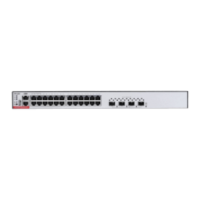Hardware Installation and Reference Guide Preparing for Installation
54
2 Preparing for Installation
2.1 Safety Precautions
To avoid personal injury and device damage, carefully read the safety precautions before you install the switch.
The following safety precautions may not cover all possible dangers.
2.1.1 General Safety Precautions
Keep the chassis clean, free from any dust.
Do not place the device in walking areas.
During the installation and maintenance, do not wear loose clothes, ornaments, or any other things that may be hooked by the
chassis.
Cut off all the power supplies and unplug all power cords before moving or handling the switch.
2.1.2 Handling Safety
Prevent the switch from being frequently handled.
Keep balance and prevent personal injuries when handling the switch
Cut off all the power supplies and unplug all power cords before moving or handling the switch.
2.1.3 Electric Safety
Observe local regulations and specifications during electric operations. Only personnel with relevant qualifications can perform
such operations.
Check whether there are potential risks in the work area. For example, check whether the power supply is grounded, whether
the grounding is reliable, and whether the ground is wet.
Find out the position of the indoor emergency power switch before installation. Cut off the power switch in case of accidents.
Do not maintain the device by yourself when the device is powered on.
Make sure that the device is powered off when you cut off the power supply.
Do not place the switch in a wet position, and keep the switch away from liquid.
Any nonstandard and inaccurate operation can cause an accident such as fire or electrical attack, thus causing severe damages
to human bodies and device.
Direct or indirect touch through a wet object on high-voltage and mains supply can bring a fatal danger.
If a power supply system is equipped with a leakage protector (also referred to as “leakage current switch” or “leakage current
breaker”), the rated leakage action current of each leakage protector is greater than twice of the theoretical maximum leakage
current of all the power supplies in the system. For example, if a system is equipped with 16 identical power supplies, the leakage
current of each power supply is equal to or less than 1.75 mA, and the leakage current of the system totals 28 mA. A leakage
protector with 30 mA rated action current supports less than nine power supplies (that is, Action current of the leakage
protector/2/Maximum leakage current of each power supply = 30/2/1.75 ≈ 8.57). In other words, the leakage protector with 30

